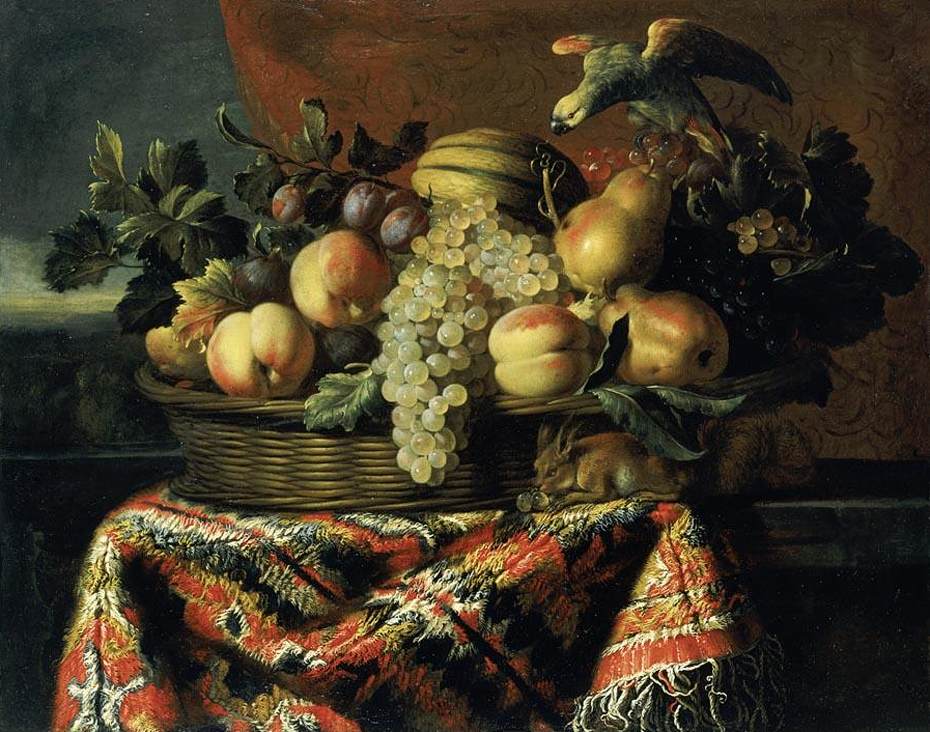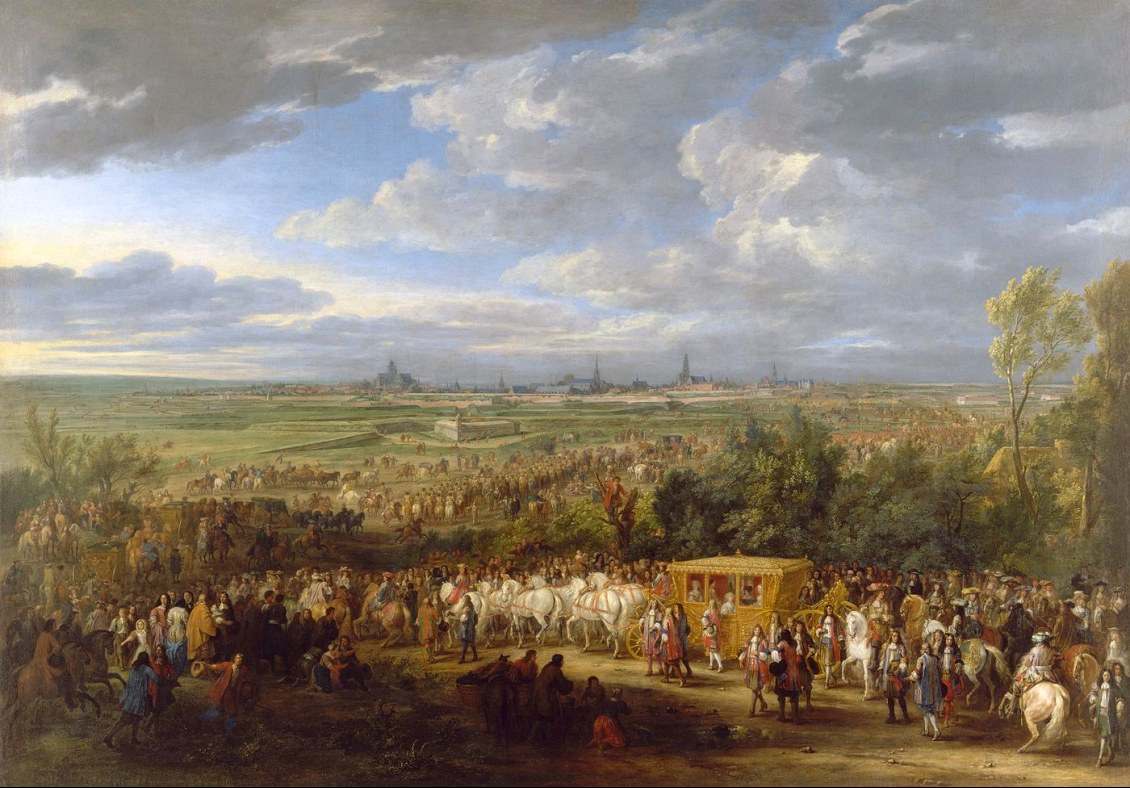|
Petrus Boel
Pieter Boel or Peeter Boel (baptized on 10 October 1622 – 3 September 1674) was a Flemish painter, printmaker and tapestry designer. He specialised in lavish still lifes and animal paintings. He moved to Paris, where he worked in the gobelin factory and became a painter to the king. Pieter Boel revolutionized animal painting by working directly from live animals in a natural setting. He thus arrived at representations of animals showing them in their natural, characteristic poses. He had many followers in France. Life He was baptized in Antwerp on 10 October 1622 as the son of Jan Boel and Anna van der Straeten. He was member of a family of artists. His grandfather Jeroom had been a painter who was registered as a master in the Antwerp Guild of Saint Luke in 1620. His father was an engraver and his older brother Quirijn de Younger became an engraver. After studying drawing with his father he became a pupil of Jan Fijt, a well-known still life and animal painter.Fran ... [...More Info...] [...Related Items...] OR: [Wikipedia] [Google] [Baidu] |
Paris
Paris () is the capital and most populous city of France, with an estimated population of 2,165,423 residents in 2019 in an area of more than 105 km² (41 sq mi), making it the 30th most densely populated city in the world in 2020. Since the 17th century, Paris has been one of the world's major centres of finance, diplomacy, commerce, fashion, gastronomy, and science. For its leading role in the arts and sciences, as well as its very early system of street lighting, in the 19th century it became known as "the City of Light". Like London, prior to the Second World War, it was also sometimes called the capital of the world. The City of Paris is the centre of the Île-de-France region, or Paris Region, with an estimated population of 12,262,544 in 2019, or about 19% of the population of France, making the region France's primate city. The Paris Region had a GDP of €739 billion ($743 billion) in 2019, which is the highest in Europe. According to the Economist Intelli ... [...More Info...] [...Related Items...] OR: [Wikipedia] [Google] [Baidu] |
Vanitas
A ''vanitas'' (Latin for 'vanity') is a symbolic work of art showing the transience of life, the futility of pleasure, and the certainty of death, often contrasting symbols of wealth and symbols of ephemerality and death. Best-known are ''vanitas'' still lifes, a common genre in the Low Countries of the 16th and 17th centuries; they have also been created at other times and in other media and genres. Etymology The Latin noun ''vanitas'' (from the Latin adjective ''vanus'' 'empty') means "emptiness", "futility", or "worthlessness", the traditional Christian view being that earthly goods and pursuits are transient and worthless. It alludes to Ecclesiastes , where ''vanitas'' translates the Hebrew word ''hevel'', which also includes the concept of transitoriness. Themes Vanitas themes were common in medieval funerary art, with most surviving examples in sculpture. By the 15th century, these could be extremely morbid and explicit, reflecting an increased obsession with de ... [...More Info...] [...Related Items...] OR: [Wikipedia] [Google] [Baidu] |
Peeter Boel-armas Y Pertrechos De Guerra
Peeter is a masculine given name, a cognate of the name Peter. It exists in Estonian, Flemish and Dutch languages. The Flemish/Dutch name may also be written as Pieter and occasionally translated as Peter. Notable people with the given name include: Estonian * Peeter All (1829–1898), Estonian fisherman, ship captain, ship owner and salvage diver * Peeter Allik (1966–2019), Estonian surrealist artist *Peeter Baranin (1882–1966), Estonian politician *Peeter Ernits (born 1953), Estonian zoologist, journalist and politician * Peeter Helme (born 1978), Estonian writer * Peeter Hoppe (born on 1960), Estonian Brigadier General * Peeter Jakobi (born 1940), Estonian actor * Peeter Jakobson (1854–1899), Estonian writer *Peeter Jalakas (born 1961), Estonian theatre director, producer, playwright and restaurateur * Peeter Järvelaid (born 1957), Estonian legal scholar and historian *Peeter Kaldur (born 1954), Estonian Lutheran clergyman *Peeter Kard (1940–2006), Estonian actor * ... [...More Info...] [...Related Items...] OR: [Wikipedia] [Google] [Baidu] |
David De Koninck
David de Coninck or David de Koninck, also known as Rammelaer (ca. 1644, Antwerp – after 1701, probably Brussels) was a Flemish painter who specialised in still lifes and landscapes with animals and hunting scenes. Recognised as a leading animal painter, de Coninck was able to develop an international career which caused him to work for extended periods in Paris, Rome and Vienna. Life He was apprenticed to Pieter Boel in 1659. Pieter Boel was an accomplished animal painter who had been trained by Jan Fyt, the leading Flemish animal painter of the mid 17th century.David de Coninck (Antwerp c. 1645 – after 1701 Brussels), ''A landscape with a ... [...More Info...] [...Related Items...] OR: [Wikipedia] [Google] [Baidu] |
King Louis XIV
Louis XIV (Louis Dieudonné; 5 September 16381 September 1715), also known as Louis the Great () or the Sun King (), was List of French monarchs, King of France from 14 May 1643 until his death in 1715. His reign of 72 years and 110 days is the List of longest-reigning monarchs, longest of any sovereign in history whose date is verifiable. Although Louis XIV's France was emblematic of the Absolutism (European history), age of absolutism in Europe, the King surrounded himself with a variety of significant political, military, and cultural figures, such as Jacques-Bénigne Bossuet, Bossuet, Jean-Baptiste Colbert, Colbert, Charles Le Brun, Le Brun, André Le Nôtre, Le Nôtre, Jean-Baptiste Lully, Lully, Cardinal Mazarin, Mazarin, Molière, Jean Racine, Racine, Henri de La Tour d'Auvergne, Viscount of Turenne, Turenne, and Sébastien Le Prestre de Vauban, Vauban. Louis began his personal rule of France in 1661, after the death of his chief minister, the Cardinal Mazarin. An adherent o ... [...More Info...] [...Related Items...] OR: [Wikipedia] [Google] [Baidu] |
Gerard Scotin
Gerard is a masculine forename of Proto-Germanic origin, variations of which exist in many Germanic and Romance languages. Like many other early Germanic names, it is dithematic, consisting of two meaningful constituents put together. In this case, those constituents are ''gari'' > ''ger-'' (meaning 'spear') and -''hard'' (meaning 'hard/strong/brave'). Common forms of the name are Gerard (English, Scottish, Irish, Dutch, Polish and Catalan); Gerrard (English, Scottish, Irish); Gerardo ( Italian, and Spanish); Geraldo ( Portuguese); Gherardo ( Italian); Gherardi ( Northern Italian, now only a surname); Gérard (variant forms ''Girard'' and ''Guérard'', now only surnames, French); Gearóid ( Irish); Gerhardt and Gerhart/Gerhard/ Gerhardus ( German, Dutch, and Afrikaans); Gellért ( Hungarian); Gerardas (Lithuanian) and Gerards/Ģirts ( Latvian); Γεράρδης ( Greece). A few abbreviated forms are Gerry and Jerry (English); Gerd (German) and Gert (Afrikaans and ... [...More Info...] [...Related Items...] OR: [Wikipedia] [Google] [Baidu] |
Académie Royale De Peinture Et De Sculpture
The Académie Royale de Peinture et de Sculpture (; en, "Royal Academy of Painting and Sculpture") was founded in 1648 in Paris, France. It was the premier art institution of France during the latter part of the Ancien Régime until it was abolished in 1793 during the French Revolution. It included most of the important painters and sculptors, maintained almost total control of teaching and exhibitions, and afforded its members preference in royal commissions. Founding In the 1640s, France's artistic life was still based on the medieval system of guilds like the Académie de Saint-Luc which had a tight grip on the professional lives of artists and artisans alike. Some artists had managed to get exemptions but these were based on favoritism rather than merit. A few "superior men" who were "real artists", suffered and felt humiliated under this system. In view of increasing pressure by the Parisian guilds for painters and sculptors to submit to their control, the young but alre ... [...More Info...] [...Related Items...] OR: [Wikipedia] [Google] [Baidu] |
Peter Van Boucle
Peter van BoucleName variations: Peter van Boeckel, Pieter van Boeckel, Pierre van Boucle, Pieter van Boeckel, Pieter van Bouck, Pieter van Boucle, Pieter van Bouck, Pieter Boucle, Pierre van Boucle (between 1600 en 1610 (?), probably Antwerp - 1673, Paris) was a Flemish Baroque painter who worked for a large part of his life in Paris where he was one of the most prolific Flemish still life painters.Pierre Rosenberg, 'Seventeenth-century French Paintings in American Collections', Réunion des musées nationaux (France), Metropolitan Museum of Art (New York, N.Y.) Metropolitan Museum of Art, 1982 Life There is little information available about the life and training of Peter van Boucle. He claimed that he was a pupil of Frans Snyders but there are no written sources available in Antwerp that support this contention. However, there are stylistic similarities in his works which suggest that he worked in the vicinity of Frans Snijders. [...More Info...] [...Related Items...] OR: [Wikipedia] [Google] [Baidu] |
Adriaen Frans Boudewijns
Adriaen Frans Boudewijns (Brussels, 3 October 1644 – Brussels, 3 December 1719) was a Flemish landscape painter, draughtsman and etcher. He was known mainly for his landscapes with trees, Italianate landscapes with architecture, rivers and villages, city, coast and country views and architectural scenes. Life Adriaen Frans Boudewijns was born in Brussels where he was baptized in the St Nicolas Church on 3 October 1644. He was the son of Nicolas Boudewijns and Françoise Jonquin. He married Louise de Ceul on 5 October 1664. The couple likely remained childless. On 23 November 1665 he was registered at the same time as a pupil and master of the Brussels Guild of Saint Luke. He was a pupil of the landscape painter and engraver Ignatius van der Stock.Adolphe Siret, '' Adrien-François Boudewyns'', in: Biographie Nationale, Volume 2, pp. 788–795, Brussels, 1868 On 16 December 1666 Boudewijns is recorded in Paris when he entered into a 3-year contract to work in the ser ... [...More Info...] [...Related Items...] OR: [Wikipedia] [Google] [Baidu] |
Abraham Genoels
Abraham Genoels II or Abraham Genouil (nickname: Archimedes) (25 May 1640, Antwerp – 10 May 1723, Antwerp) was a Flemish Baroque painter, draughtsman, engraver and tapestry designer. He is now mainly known for his landscape paintings, drawings and prints. He had an international career that saw him work in Paris, Rome and Antwerp.Hans Devisscher. "Genoels, Abraham, II." Grove Art Online. Oxford Art Online. Oxford University Press. Web. 3 April 2014 Life  Abraham Genoels was born on 25 May 1640 in Antwerp as the ...
Abraham Genoels was born on 25 May 1640 in Antwerp as the ...
[...More Info...] [...Related Items...] OR: [Wikipedia] [Google] [Baidu] |
Adam Frans Van Der Meulen
Adam Frans van der Meulen or Adam-François van der MeulenAdam Frans van der Meulen at the (11 January 163215 October 1690) was a Flemish painter and draughtsman who was particularly known for his scenes of military campaigns and conquests.Christine van Mulders. "Meulen, Adam Frans van der." Grove Art Online. Oxford Art Online. Oxford University Press. Web. 4 September 2017 Van der Meulen also painted portraits, hunting scenes, paintings of chateaux and landscapes. He created designs for prints and |



_Allegorie_der_Wachsamkeit.jpg)



